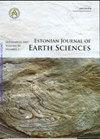Developing a phylogenetic framework for tiny Ordovician brachiopods (Atrypida: Anazyginae and Catazyginae) from the eastern United States
IF 0.8
4区 地球科学
Q4 GEOSCIENCES, MULTIDISCIPLINARY
引用次数: 0
Abstract
Elucidating how environmental change can facilitate the differentiation of evolutionary lineages and the establishment of new species is a critical issue for understanding both the history of life and modern biota. Notably, speciation events are known to be the main drivers of bio - diversification; thus, generating well-constrained phylogenetic hypotheses to investigate speciation processes and facilitators can provide key data on links between biogeography, speciation, and diversification. During the Great Ordovician Biodiversification Event (GOBE), articulate brachiopods were a key group on the rise. By the Middle to Late Ordovician, the brachiopod order Atrypida was no exception. The atrypids diversified greatly and established evolutionary novelties such as helical and calcite-supported lophophores. The Ordovician epi - continental seas in eastern Laurentia provided an excellent environment for reproductive isolation and speciation, with sea-level fluctuations, ideal climate conditions, and active tectonic settings. However, speciation patterns and drivers within two widely-distributed atrypid sub - families, Anazyginae ( Anazyga spp. and Zygospira spp. ) and Catazyginae ( Catazyga spp. ) , remain poorly known. In this project, we seek to develop a robust phylogenetic framework for these clades and use that framework to evaluate speciation processes and facilitators during the Late Ordovician. Morphological data will be collected from published美国东部奥陶系小型腕足动物系统发育框架的建立(atrypa: Anazyginae和Catazyginae)
阐明环境变化如何促进进化谱系的分化和新物种的建立是理解生命史和现代生物群的关键问题。值得注意的是,已知物种形成事件是生物多样化的主要驱动力;因此,产生约束良好的系统发育假说来研究物种形成过程和促进因素可以为生物地理学、物种形成和多样化之间的联系提供关键数据。在大奥陶纪生物多样化事件(GOBE)中,有节肢肢动物是一个正在崛起的关键类群。到奥陶世中晚期,腕足目Atrypida也不例外。非典型体的多样性极大,并建立了进化上的新颖性,如螺旋状和方解石支撑的磷光体。劳伦西亚东部奥陶纪外陆海具有良好的海平面波动、理想的气候条件和活跃的构造环境,为繁殖隔离和物种形成提供了良好的环境。然而,在两个广泛分布的非典型亚家族中,Anazyginae (Anazyga spp.和Zygospira spp.)和Catazyginae (Catazyga spp.)的物种形成模式和驱动因素仍然知之甚少。在这个项目中,我们试图为这些分支开发一个强大的系统发育框架,并使用该框架来评估晚奥陶纪的物种形成过程和促进因素。形态学数据将从出版物中收集
本文章由计算机程序翻译,如有差异,请以英文原文为准。
求助全文
约1分钟内获得全文
求助全文
来源期刊

Estonian Journal of Earth Sciences
地学-地球科学综合
CiteScore
1.50
自引率
9.10%
发文量
11
审稿时长
>12 weeks
期刊介绍:
The Estonian Journal of Earth Sciences is an international scientific open access journal published by the Estonian Academy of Sciences in collaboration with the Tallinn University of Technology, the University of Tartu, the Estonian University of Life Sciences and the Talllinn University.
The journal publishes primary research and review papers in the English language. All articles are provided with short Estonian summaries.
All papers to be published in the journal are peer reviewed internationally.
The journal is open for publications in all fields of Earth sciences, including besides different geological sensu lato disciplines, also geography and oceanography having certain connection with our part of the world, North Europe and the Baltic area in particular.
 求助内容:
求助内容: 应助结果提醒方式:
应助结果提醒方式:


